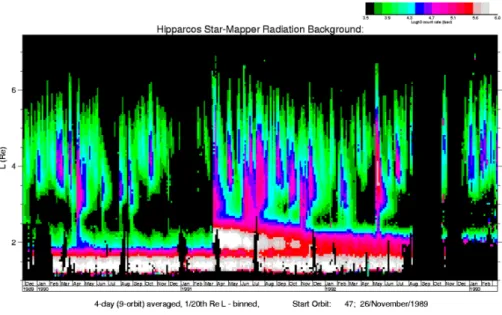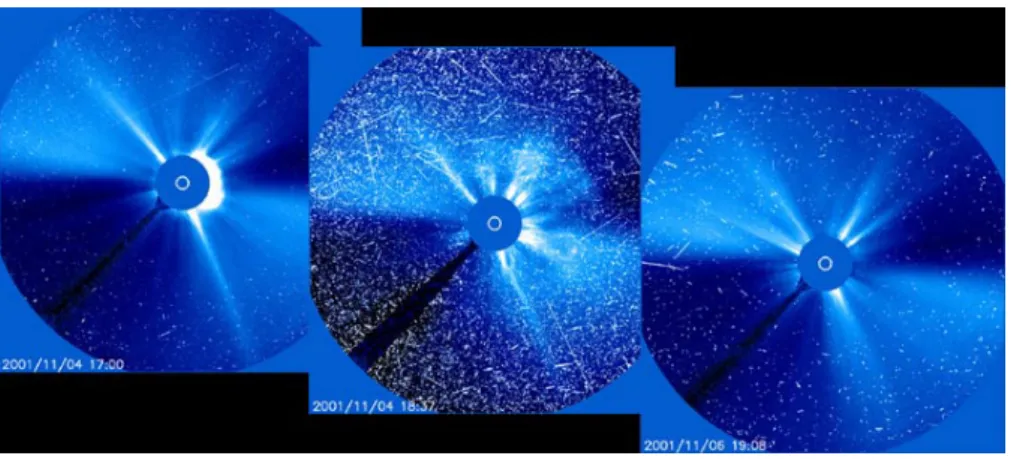HAL Id: hal-00317054
https://hal.archives-ouvertes.fr/hal-00317054
Submitted on 1 Jan 2002
HAL is a multi-disciplinary open access
archive for the deposit and dissemination of
sci-entific research documents, whether they are
pub-lished or not. The documents may come from
teaching and research institutions in France or
abroad, or from public or private research centers.
L’archive ouverte pluridisciplinaire HAL, est
destinée au dépôt et à la diffusion de documents
scientifiques de niveau recherche, publiés ou non,
émanant des établissements d’enseignement et de
recherche français ou étrangers, des laboratoires
publics ou privés.
EditorialThe science of space weather
M. Hapgood
To cite this version:
M. Hapgood. EditorialThe science of space weather. Annales Geophysicae, European Geosciences
Union, 2002, 20 (7), pp.875-877. �hal-00317054�
Annales Geophysicae (2002) 20: 875–877 c European Geophysical Society 2002
Annales
Geophysicae
Editorial
The science of space weather
M. HapgoodRutherford Appleton Laboratory, Oxfordshire, UK
This special issue of Annales Geophysicae is devoted to the science of space weather. This subject has become a hot topic in recent years as a result of the growing appreciation that many phenomena in the space environment around the Earth can affect human beings and their technological sys-tems. These phenomena are ultimately driven by activity on the Sun. Thus the science of space weather is deeply concerned with the origins and manifestations of solar ac-tivity and with the propagation of solar-originated effects through the heliosphere to locations where human activities take place. This, of course, is predominantly the Earth and the region of space immediately surrounding it. But our ex-ploration of the solar system means that we must also be aware of space weather effects beyond the Earth - both for the robotic probes currently used for exploration and to be ready for human exploration when that is finally realised.
But space weather is not just science. It is concerned with phenomena that can directly affect other human activities, so it is important to understand how the science of space weather can interact with those activities. Many of the peo-ple who run technological systems affected by space weather are interested to know about the science and to explore what it can do to help them. But they want good science, e.g. in-formation on the size and frequency of effects. They will then to use this to see if they can design out space weather effects at reasonable cost. If not, they will then see if there are reasonable precautions that they can take in response to reliable estimates of current or future conditions. The key point is that the practical response to space weather must be reasonable - in particular terms of costs.
But to be truly effective that practical response must be un-derpinned by an understanding of the physical mechanisms of space weather phenomena. For example, our current un-derstanding of dayside reconnection is far from perfect but is sufficient to allow us to be confident in using upstream measurements of the solar wind plasma and magnetic field to provide short-term warnings of geomagnetic activity. In prin-ciple, one could base these warnings purely on the
statisti-Correspondence to: M. Hapgood (M.Hapgood@rl.ac.uk)
cal relationships between geomagnetic activity and upstream data. But our physical understanding gives us much greater confidence in scope and validity of those warnings. Physi-cal understanding also helps the community to seek financial and political support for space weather applications. It allows us to demonstrate that we really understand the problem and thus that the proposed work is truly worth supporting. Put bluntly, it makes it easier to “sell” space weather to sources of funding.
However, it is equally clear that there remains considerable scope to improve space weather applications by improving our knowledge of the underpinning science. In some cases we need to improve detailed scientific understanding in or-der to advance existing space weather applications. A prime example would be the provision of advance warnings of ge-omagnetic activity based on observations of coronal mass ejections (CMEs). Here it is essential to develop the abil-ity to model the propagation of the CME from the Sun to the Earth and thus predict the sign of Bzon arrival at Earth. In other cases we lack physical understanding and thus can de-velop space weather applications only on a statistical basis. A prime example would be solar proton events. There is, as yet, no scientific consensus on the source region where these particles are accelerated to high energies. Thus it is hard to build a reliable application to predict individual solar pro-ton events. What is possible, of course, is to build statistical models of the cumulative exposure to solar protons over a pe-riod of time, e.g. the JPL 91 model of Feynman et al. (1993). These models can then be used to guide the design of systems that must cope with solar proton events. This is essentially a conservative engineering approach and is clearly an excellent way to work round space weather problems while the under-pinning scientific knowledge is poor. For example, Fig. 2 shows solar proton induced power losses on ESA’s Cluster mission. The solar array design includes a margin for these losses; this was calculated using the JPL 91 model.
This it is important to identify the areas where further sci-entific research is needed to improve our understanding of space weather. In Europe this has recently been addressed as part of two ESA studies of a European space weather
pro-876 M. Hapgood: The science of space weather
Fig. 1. One key area affected by space weather is other scientific research in space. This figure shows noise induced in the star-mapper
on ESA’s Hipparcos astronomy mission (Daly et al., 1994). Due to launch problems, Hipparcos ended up on a elliptical orbit through the radiation belts. The radiation background is ordered by the McIwain L parameter. The resulting pattern is similar to that of high-energy electrons in the radiation belt, suggesting that these are the source of that background. Courtesy ESA (E. Daly).
Fig. 2. Solar array power for the 4 Cluster spacecraft. The annual modulation due to the varying Earth-Sun distance was interrupted by
abrupt downward steps during a solar proton event in late 2000 and again by 3 events in late 2001. Courtesy ESA (J. Volpp).
gramme (see note at end). While the main focus of the two studies was on applications, they both looked at the science underpinning those applications and discussed the need for further research. They identified a number of key areas in which further work would be very valuable:
– The conditions leading to ejection of material from the
Sun
– The propagation of those ejecta, and their embedded
magnetic fields, from the Sun to the Earth
– The acceleration of energetic particles both in the
helio-sphere (solar protons and electrons) and in the radiation belts of the Earth and other planets
– A much deeper understanding of how reconnections
works, e.g. to resolve controversies over the location and, in particular, the extent of reconnection regions.
– Magnetospheric dynamics, especially during major
M. Hapgood: The science of space weather 877
Fig. 3. SOHO has advanced our knowledge of space weather. This series of images from the LASCO coronagraph shows the launch of a
CME on the right of the Sun, followed 90 min later by the arrival of solar protons (indicated by the “snowstorm” effect in the middle image). Image courtesy ESA.
– The coupling of the space environment to the neutral
atmosphere of the Earth and other solar system bodies
– The size and frequency of extreme space weather
events.
These topics lie at the heart of contemporary solar-terrestrial physics and are widely considered to be of great scientific interest independently of the needs to improve space weather services. For example, ESA’s recently-selected Solar Orbiter mission is intended to build on the success of SOHO in addressing the first two topics in the list above. Similarly, ESA’s Cluster and Ulysses mission are addressing other topics such as magnetospheric dynam-ics (Cluster) and heliospheric particle acceleration (Ulysses). Furthermore, some of these topics address fundamental prob-lems in the physics of collisionless plasmas and are there-fore fundamental issues in our understanding of the physical universe. Thus there is considerable scope for further fun-damental research that will also be of great benefit to our understanding of space weather. It is important, indeed es-sential, for the STP community in Europe to communicate this idea to funding bodies. We must raise the profile of space weather-related research, make decision-makers aware of the importance of particular scientific issues and provide a base on which individual science groups can develop proposals for funding new space weather science.
This special issue is a collection of high-quality papers on a variety of space weather topics including the propagation of solar ejecta from the Sun to the Earth and the behaviour of high-energy electrons in the outer radiation belt. It has its origins in the Space Weather session organised at the 2001 EGS meeting in Nice. Following that meeting a call for papers was issued both to participants in the Nice meeting and to the broader space weather community. As a result we now have a collection of 19 papers giving a broad view of current space weather research.
Note. For information on the ESA space weather studies, see the ESA web site athttp://www.estec.esa.nl/ wmwww/wma/spweather/or the RAL site athttp://
www.wdc.rl.ac.uk/SWstudy/.
References
Daly E., van Leeuwen, F., Evans, H. D. R., and Perryman, M. A. C.: Radiation-Belt and Transient Solar-Magnetospheric Effects on Hipparcos Radiation Background, IEEE Trans. Nucl. Sci., NS-41, 2376–2382, 1994.
Feynman, J., Spitale, G., Wang, J., and Gabriel, S.: Interplanetary proton fluence model: JPL 1991, J. Geophys. Res., 98, 13 281– 13 294, 1993.

